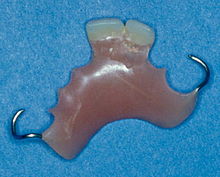Interim prosthesis
An interim prosthesis ( lat. Interim "meanwhile, temporarily", also transition prosthesis , provisional prosthesis ) is a temporary prosthesis to replace missing teeth. It is intended to bridge the period between tooth removal and the final restoration. During this time, the wound can heal or the healing time of dental implants and the production of the dentures can be bridged.
construction

An interim prosthesis is usually of a simple design and consists of a plastic base, the teeth to be replaced and simple brackets made of steel wire that hold it in place. An interim prosthesis can be made either before or after surgery. If it is made before the procedure, an impression of the jaw is first made and this is filled with plaster of paris. The dental technician grinds the teeth to be extracted on the plaster model and manufactures the interim prosthesis on it, which is inserted immediately after the surgical procedure.
Difference to the immediate prosthesis
An interim prosthesis is considered a temporary solution. It is not a prosthesis that can be worn permanently. In contrast, the immediate prosthesis is used for immediate restoration. It is incorporated as a definitive denture immediately after the teeth have been removed and adapted to the new anatomical conditions after the healing phase, which lasts several weeks.
Wearing time
An interim prosthesis is not worn longer than necessary (about 6 to 8 weeks). Their simple, non-periodontal (on the teeth) supported construction can lead to excessive degradation of the jawbone ( atrophy ) if worn for a long time.
See also
Individual evidence
- ↑ Der kleine Stowasser : Latin-German school dictionary
- ↑ Peter Pospiech, The prophylactically oriented supply with partial dentures: 7 tables . Georg Thieme Verlag, 2002, ISBN 978-3-13-126941-6 , pp. 160-161.
